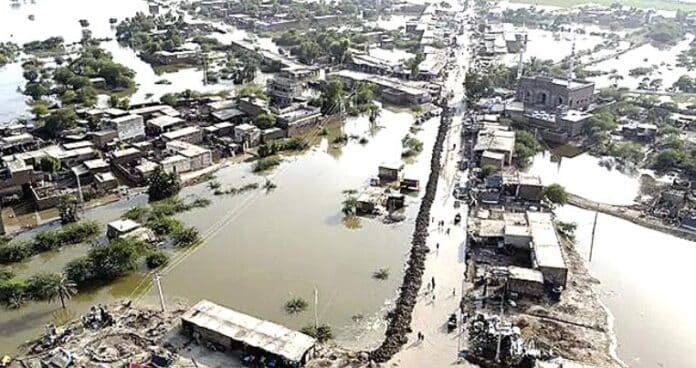Pakistan ranks number 8 on the list of countries most affected by extreme weather events (floods, storms, heatwaves, etc.), according to the Global Climate Risk Index (GRCI). Recent floods in the country sufficiently demonstrated how climate change is Pakistan’s worst enemy as they have wiped out entire villages. The latest death toll has reached 1,061, and as per the Minister for Planning and Development, financial damages may exceed 10 billion USD, an amount equal to nearly 4% of the country’s annual GDP. Even though it’s a natural disaster, the consequences might not be similar in every country. It is because the impact of climate change varies depending on geographic, ecological, and economic conditions, which determine if the country can cope with the worst possible outcome. It is understandable that low-income countries with poor living conditions suffer more than rich countries with better living conditions as they have the resources to raise awareness and implement safety protocols to reduce the damage from such disasters.
Pakistan is a developing country with poor economic and human development indicators. World Bank reported that about 39.3% of the population in Pakistan was living below the poverty line (3.2 USD per day) in 2020-2021. Moreover, its Human Development Index was 0.57 in 2020, ranking 154th out of 189 countries. Understanding the country’s economic standing is important before identifying the significant factors that make Pakistan vulnerable to climate change. Another fact to consider is the relationship between human-induced climate crises and natural weather events. Climate change significantly affects extreme weather events, increasing their intensity, frequency, and duration.
Pakistan is a Victim of Second-Hand Climate Crises
If the basic reason for climate change and global warming is the use of fossil fuels, then Pakistan is not even 1% responsible. The rich countries that are sending aid to Pakistan have gotten richer by burning extraordinary amounts of fossil fuels, putting poorer countries at risk of climate disasters. Ever since the 2015 Paris Agreement, the negotiators have been hoping to achieve a common ground on funnelling cash to high-risk countries. However, the US has been blocking every effort to establish such a payment system.
Pakistan is the most glaciated country in the world that has faced recurring natural disasters, from heatwaves, sea storms, and droughts to flash floods and landslides. The International Federation of Red Cross (IFRC) assessed that increase in temperature across the country, especially in the north, would lead to rapid glacial melt, increasing the chances of Glacier Lake Outburst Floods (GLOF) and changing the downstream flow of the Indus River. Combine that with the unpredictable rainfall, and Indus Basin Delta is at risk of submerging in water.
4 countries share The Indus Basin; Pakistan, India, China, and Afghanistan, with 1.65 billion inhabitants. The International Centre for Integrated Mountain Development (ICIMOD) warned in a 2019 report that if global warming stays below 1.5-degree celsius, 36% of the volume of the glaciers in the Hindu Kush Himalayan (HKH) region would be reduced. And, if the world warms above 2 degrees celsius (predicted with the current rate of fossil fuel consumption), 49% of the volume will be shredded. One can imagine where all that water will go. As most of the surrounding area is desert, the Indus Basin, which is a vital region for crop growth, is in huge danger of getting submerged.
Rapidly Altering Landscape
A major problem that makes Pakistan vulnerable to climate crises is its dependency on agriculture. The country heavily depends on its climate-sensitive resources (land, water, trees, etc.) for living, food, and employment. As water resource is already scarce, almost 90% of agricultural activities depend on irrigation from the Indus River full of glacial melt. The glaciers will keep on melting faster with unpredictable rainfall and increasing temperature, causing loss to crops, livestock, lives, livelihoods, and infrastructure. Pakistan has a very low capacity to adapt to climate change due to poor scientific and technological understanding of agriculture.
Another devastating impact of climate change in Pakistan, which is often overlooked, is mass migration. The country has seen massive climate-induced migration since 2010 due to extreme weather events. According to the Centre for Strategic and Contemporary Research (CSCR), approximately 2 million people are at risk of becoming “climate migrants” by 2050. A study by ActionAid and Climate Action Network estimated that rising sea levels, water scarcity, loss of ecosystem, low crop yields, and drought had already forced more than 18 million people in South Asia to migrate. In 2020, there were about 680,000 climate migrants in Pakistan alone. Interestingly, these numbers do not include record displacements from 3 major floods of 2010, 2011, and 2014. The scale of migration will continue to rise as its the 5th most populous country in the world.
Dependant Economy
Recently, International Monetary Fund (IMF) released a 1.1 billion USD for the government; This money was a part of the 2019 bailout package, which was held up due to the previous government led by Imran Khan refusing to meet the IMF’s demand to cut energy subsidies. The IMF said the total support amount given to Pakistan so far in this programme had reached 3.9 billion USD. It also extended the program till June 2023, bringing the figure to approximately 6.5 billion USD. However, the need for loans and the cost of rehabilitation will exacerbate since the Indus delta, the major region in Pakistan for agricultural produce is vulnerable to high floods caused by glacial melt and higher than abnormal rains due to climate change; this will result in loss of livelihood for the rural population, increase in mass migration, higher cost of food due to lower supply and destruction of vital infrastructure. Consequently, Pakistan would require further aid and loans to help climate change migrants, to build resilient supply chains and to develop sustainably. The country which is facing the issue of external debt servicing will need more financial resources to meet these additional costs of dealing with climate change consequences.


